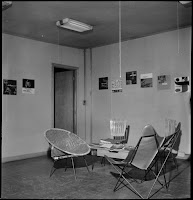THIS was Jimmy Smith's 19th recording session for Blue Note since he'd joined the label 29 month earlier. Jimmy Smith had revolutionized the sound and the use of the organ in jazz and he became incredibly popular very quickly. Fortunately for Blue Note, he was also prolific. Still the label couldn't get sessions out fast enough. Jimmy and producer Alfred Lion seemed to settle on four basic rotating contexts in which to record: Smith's working trio (studio and live), an all-star trio (usually Kenny Burrell and Art Blakey), a quartet with Lou Donaldson (later Stanley Turrentine) and jam sessions with three-horn front lines made up of Blue Note regulars like Donald Byrd, Lee Morgan, Blue Mitchell, Curtis Fuller, Donaldson, Jackie McLean, George Coleman, Tina Brooks, Hank Mobley and Ike Quebec.
This session, issued now for the first time, is somewhat different in two respects. While it wasn't unusual for ringer Art Blakey and Jimmy's regular drummer Donald Bailey to split the drum chores (as they do here), it was unusual for the single horn to be anyone but Lou Donaldson. The choice of baritone saxophone in general and Cecil Payne in particular was an odd one. An excellent player, Cecil, for some reason, was not a Blue Note regular. In fact, he'd only appeared on the 1948 James Moody sides, when both men were in Dizzy Gillespie's orchestra, and on Kenny Dorham's 1955 album Afro-Cuban. And after the session in hand/ he only appeared one more time on a 1961 Tadd Dameron session, which has just been issued on the CD, The Lost Sessions. Perhaps the idea was Burrell's, who'd featured Cecil on his Prestige album Blue Moods the year before. At any rate, this was a peak period for Payne who was in the middle of a long tenure with pianist-composer Randy Weston. It's great to hear him stretch out in this context.
What's even more unusual is the choice of material. Though Jimmy Smith was a fiery blues player who practically created the chitlin circuit of the fifties, he was a fully-equipped jazz artist as likely to play a Monk tune, a be-bop line or an old standard as a soulful blues. His records always reflected his range. Yet this session is an all-blues program, which may be why it was passed over for release over the years. Another reason may have been sonic; each time Cecil Payne finished soloing, engineer Rudy Van Gelder would close his microphone, which changed the sound of the recording abruptly.
Nonetheless, Smith and his superb cast find infinite variety and creative inspiration in the blues form. Art Blakey is present for the first half of the session, which opens with a relaxed reading of the 1914 W.C. Handy tune "St. Louis Blues".
The next piece was "The Swingin' Shepherd Blues," a left field 1958 hit by Canadian flutist Moe Koffman. This was such an inescapable record at the time that every saxophonist was looking through his closet to find his flute. There were dozens of cover versions, and Buddy Collette even organized a group called Four Swingin' Shepherds with Bud Shank, Paul Horn, Harry Klee and the leader all playing different sized flutes. Fortunately, Jimmy and Alfred had the sense and good taste to do a version without flute. This track was issued on Blue Note 45-1711.
Blakey's last tune was the first of four Jimmy Smith blues, a relaxed, medium-up blues with a great walking bass line courtesy of Smith's feet.
Donald Bailey, a Philadelphian who'd joined Smith's trio in time for the organist's second Blue Note session in March 1956, completes the date. Bailey stayed with Smith until well into 1 963, when he settled in Los Angeles where he later joined The Three Sounds and pianist Jack Wilson's trio. Besides freelancing heavily on drums, he also eventually developed a second career playing harmonica.
Jimmy seems intent with his originals on showing and exploring the variety that the blues form has to offer. Blues No. 2 has a shuffle feel; Blues No.3 is in the great slow blues tradition that Smith set with "The Sermon" and Blues No. 4 is a fast, modern bop line with some blistering organ.
This may not be the most earth-shattering of Jimmy Smith's 31 recording sessions for Blue Note, but it is a delightful addition to his incredible and influential legacy at the label. Anytime Smith and Burrell get together (and they still do!), it's a delightful musical experience. And hearing Cecil Payne in this relaxed blues context is an added bonus.
—MICHAEL CUSCUNA, 1999





